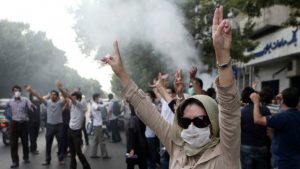Iran is facing its worst civil unrest in almost a decade, with at least 22 people killed in street demonstrations that began in a reaction to tough economic times, like reported by theweek.co.uk.
Iranians were promised in 2015 that the easing of sanctions would make their lives easier, with oil revenue restored after years of embargo. But there has been no recovery. In fact, according to the BBC’s Persian service, the average Iranian is now 15% worse off than they were ten years ago.
So, where is the oil money going?
Some protesters want Tehran to stop spending what they say is “vast amounts of money” on supporting the Syrian regime of President Bashar al-Assad, the Lebanese Shia group Hezbollah and the Palestinian Hamas movement, Deutsche Welle reports.
In an interview with The Times of Israel, Israeli government minister Yuval Steinitz says that Iran spends $1bn (£740m) each year just on Hezbollah.
Left-wing Israeli newspaper Haaretz quotes unnamed “Western intelligence sources” who claim that hardliners want to “capitalise” on money spent during Syria’s civil war to “entrench [Iran’s] presence by building a permanent air base and docking facilities on the Mediterranean coast”.
This would cost “at least hundreds of millions, if not billions”, the newspaper says, money that factions close to Iranian President Hassan Rouhani want to reserve for “improving infrastructure and providing jobs at home”.
According to Haaretz, Iran’s state-owned banks set up credit lines totalling $4.6bn (£3.4bn) for the Syrian regime in 2013 and 2015. It has paid a monthly wage to around 50,000 militia fighters, and has supplied arms “daily”, and military “advisers”.
Estimates of Iran’s total funding for Hezbollah in Lebanon vary from $60m (£44m) to $1bn a year, the newspaper adds, while Israeli intelligence estimates Iranian backing to Islamic groups in Gaza adds up to some $100m (£74m) annually.



